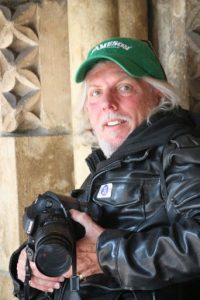
In writing, a cliche is to be avoided at all cost, yet sometimes a cliche must be given voice in making a point needing to be made. It is said those who forget history are doomed to repeat it, people, the larger group we call society and humanity ever amazed that their same wrong focused actions, prejudices and hates repeated over and over throughout history elicits much the same results. Human souls, people treated like chattel, their plight ignored, or worse taken advantage of are going to endeavor to escape their oppression, will rebel against the wrongful person(s) who enslave their bodies attempt to crush their souls and spirit.
“We shall overcome, we shall overcome, we shall overcome some day …”
What then happens when the history we should remember is (perhaps callously and deliberately) buried, hidden away, or worse destroyed to make way for something far less valuable than a historical touchstone with our past shared history, and integral part of the fabled “Underground Railroad”? In Nyack where the homes of so many history making people are meticulously preserved, the most famous being the Hopper House on North Broadway, how is it that the home of Cynthia Hesdra was razed to the ground to put up a nondescript cinder-block building of questionable if any social value?
It would not be a far stretch to say the demolishing of this historical structure had a great deal to do with certain people of power wanting to forget a part of their own history that comes with more than a bit of shame, the powers that be convinced that out of site would be out of mind. Why is it that so much of the story of Cynthia Hesdra cannot be found, and what is found flawed in so many ways? Her Wikipedia page is not only woefully lacking, it is listed as an Orphan Page, devoid of even a picture of this noble woman. More than sad, this seems a tragic wrong that some noted historian should work to correct. Surely her story is one worthy of being told in its entirety?
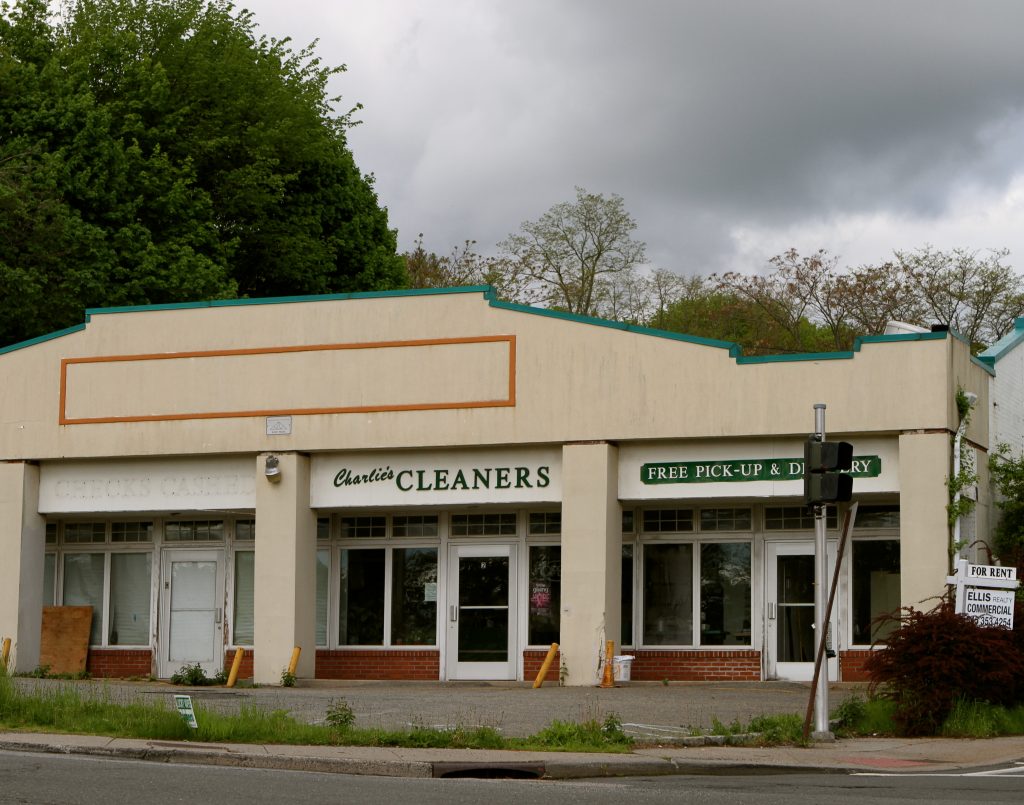
station on the “Underground Railway”. It is noted here, that local citizens in 1970 decided to save
and restore the childhood home of Edward Hopper…said home had fallen into a state of sad
disrepair. However, in 1977 when it was decided that the Hesdra House had fallen into a state of disrepair, the community instead of saving this important historical home instead opted to have it demolished.
Almost every American knows the bravery, and strength of character of Harriet Tubman, yet few people know who Cynthia Hesdra is, unaware of her contributions to history, her key piece of the story that is the “Underground Railroad” at best glossed over. Hers is a story that in some ways has been buried, destroyed in every way, the house she lived in, the house that was Nyack’s Train Station along the route to a better life for men and women risking all, the house that hid hundreds of slaves who had a dream, a singular goal, had embarked on perilous journeys North in search of what we all search for, Freedom, demolished in the late 1970’s in the name of progress. There is a certain blissful irony that Cynthia would probably appreciate in that use of the word progress…forward or onward toward a destination. In destroying the house that held so much history that had so many stories to tell, they give us a “Readers Digest” condensed version of her purpose…helping others forward or onward toward a destination.
Nyack Brook which played a part in thousands of journeys to Freedom and a better life is now mostly buried, it’s path hidden under buildings, fed through culverts, as it makes its way down to Memorial Park where slaves would huddle waiting for boats that would carry them north on the Hudson River to their next stop as they moved toward their final destination, often times in Canada. If you are willing to hunt for it, there are still a few sections of this historic brook that can be seen, and if you get quiet, listen with your eyes closed and your mind open, you can almost hear voices whispering in the rushing waters, can visualize the stories of those who saw that brook as part of their own route to Freedom, their path to a life lived free of servitude. Again, the irony that such an important brook, an important part of the path that was/is the “Underground Railroad” now underground, hidden from view, much like the humans escaping slavery, risking all in a race toward Freedom.
The sun occasionally peeking through steely slate gray clouds threatening rain at any moment, I took a walk along the likely path of Nyack Brook, my thoughts wondering hap hazard through history as I tried to imagine taking my own journey to Freedom, focusing in on the fear, risks and perils faced by people wanting nothing more than a better life. As my mind wondered, moving up and down a time line that started long before I was born, and pointing toward a future I will never see, it came to me that these journeys have always been, and probably will always be. In the depth of our souls, the flames of freedom burn hot, will never be extinguished by seeking to silence our hopes and dreams.
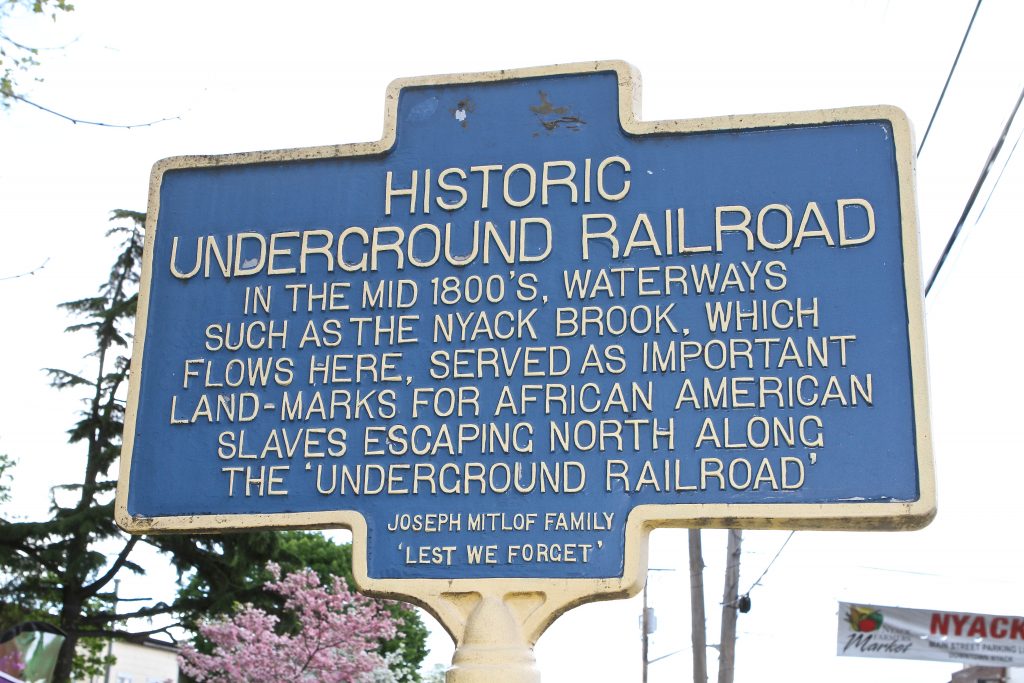
Political climates targeting certain minorities, wars and civil wars in far off lands such as Syria, never ending oppression of people by groups with names like “The Taliban” or “Isis” forcing people to abandon homes, flee countries, all of them looking for something we all are supposedly born with…Freedom. Safe Houses, train stations along the “Underground Railroad” for the most part gone, forgotten, now replaced with Churches, and Sanctuary Cities as people step up to lend a helping hand to those fleeing persecution, perhaps escaping a modern day version of servitude or even slavery, risking everything in the hopes of providing a better life for themselves and their family. Each of these people have a story to tell, own a small part of the puzzle that is history, yet most of those stories are not being shared, perhaps dooming us to continue repeating a shameful pattern of not learning from a history we have already lived over and over again.
Great migrations around the world, as oppressed individual humans within the larger group we call humanity (talk about an oxymoron) leave home and country to escape dictatorial leaders, or abject poverty, risking everything in hopes that their new destination will provide them a better life, or a freedom they have never known, their success to some degree dependent upon the kindness of strangers they meet along the way, a helping hand when they need it the most. When that moment arrives, in what camp will we each stand? That answer more than likely depends upon our understanding of history, our own journey, and most importantly, our own humanity, our love and respect of people who have walked a different journey from there to here, but who, like us are just human beings trying to get through this journey we call life.
Perhaps it is time we learn from our past, perhaps not only providing a platform for people to share their stories but choosing the task of both listening and hearing their stories. In that task of listening and hearing we as a society can add to the rich fabric of history give it more depth as various hues and colors that have gone unseen pop into focus and with that newfound focus on different threads in the warp and weave could we finally learn from our past, and in that learning dare we hope that mankind can stop its inhumanity, veer off the path that has been too often traveled, choosing instead that proverbial road less traveled? Could or would such a choice change our individual journeys, and if enough of us choose that road less traveled could it lead us not just to freedom, but global unity as well?
Black Lives Matter…a simple truth in three simple words. Accepting such a simple truth is not saying your life does not matter, but instead gives each of us individually, and collectively as humanity a chance to listen, an opportunity to hear a story that is not our own, one we are not familiar with and in that hearing perhaps in turn we can share our own story, and in the sharing of stories find a common ground that would allow us to walk down a shared path to dreams we all hold in common.
“We’ll walk hand in hand, we’ll walk hand in hand. We’ll walk hand in hand some day…”
We should not have to demand validation to give it, and that which is freely given will usually come back to us tenfold as blessings find a way to say hello in the most unexpected of ways. Cynthia Hesdra’s story, her part in the “Underground Railroad” has not been fully heard, and it deserves to be, just as your story, my story, and everyone’s story should be fully heard with an open mind, and an open heart.
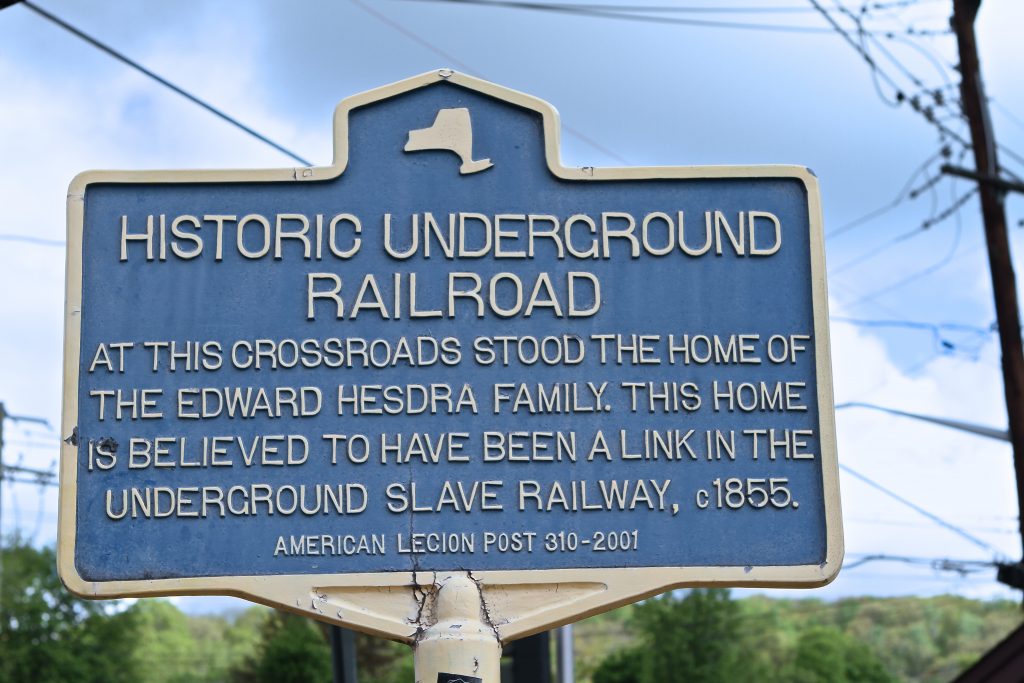
Ask yourselves, would the “Underground Railroad” even exist if 150 years ago a group of people had not embarked upon a journey, had not their own harrowing stories to tell, if people had not listened to the stories of slaves with an open heart, knowing instantly they had to do something to help, had to act, even if doing so risked their own lives, to give their fellow human beings the gift that each of us deserves? Helping slaves was a serious offense, “The Fugitive Slave Act” passed in 1793 made it illegal to aid slaves in the entire United States, and expansion of the law in 1850 allowed for Bounty Hunters (called Blackbirder’s) to hunt down runaway slaves…it is noted here, that often times even Free Men and Women who were Black were kidnapped and forced into slavery.
Some antidotal information suggests Cynthia Hesdra was born into slavery, her father a rich and powerful businessman in the Rockland County community, her mother which little is known about a slave. Other sources suggest her mother and father, John and Jane Moore were married, making Cynthia a Freeborn from birth. Whichever is truth; all sources confirm that she spent a portion of her early life as a slave until her future husband was able to purchase her freedom. Another irrefutable fact is Cynthia was a smart business person who by today’s standards would have been a multi-millionaire with real-estate and business holdings worth over three million dollars.
A woman of color in the 1800’s, at one time a slave for life, who once free builds a fortune in business and real estate holdings, operates two small lending institutes, who dies by today’s standards a millionaire is an incredible story, a story worthy of a documentary, or even a full blown epic movie made for the silver screen. Couple in the high drama of the court case surrounding her fortune after she died, and her story is the stuff worthy of a Oscar Nomination, yet over 100 years after her death so much of her own journey remains a secret, the majority of her life shrouded in mystery and intrigue.
We have but scratched the surface of this remarkable woman whose story includes far more than her time as a slave, far more than the wealth she accumulated over a life time of hard work. Her life experiences saw her willing to risk everything including her wealth to provide nurture, sustenance, safe harbor and assistance to slaves who themselves were willing to risk everything including their lives to find and know freedom, she was a Freedom Fighter and Civil Rights leader who like her peers down through the ages such as Harriet Tubman, Martin Luther King Jr., Rosa Parks, Malcolm X, Andrew Goodman and others willing to lay her life on the line to do the right thing. That is a story worth an exhaustive historical search an investigation, a story that needs both told and preserved.
How do we do that?
A good start would be forming a group whose sole purpose was to reclaim the land that her home was on, doing the research necessary to construct a reasonably accurate replica of the home that was tragically torn down in the name of progress, turn that space/that lot into the “Cynthia Hesdra Underground Railroad Museum”. Further, the now vacant commercial site across the street could be purchased, turned into an African Studies and Community Center bearing her name. A tall order, a huge dream, but as Martin Luther King said, “I have a dream” and this writer believes that dream is worth some serious pursuit as we collectively search for ways to find the missing pieces of the puzzle that represent the life story of a remarkable woman and human being.
A Mini Tour of Historical Sites Related to Cynthia Hesdra, Underground Railroad and Black History in Nyack Area
1.) Mount More Cemetery…located in the Shadow of Palisades Mall. A tour of this cemetery, the desecration of it will bring tears to your eyes.
2.) Historical Marker Identifying Former Site of Cynthia Hesdra home and Underground Railroad Station…can be found on North East Corner or Main St (Route 59) and Route 9 in Nyack.
3.) Small Accessible above ground section of Nyack Brook which was part of the Underground Railroad slaves followed in their quest for Freedom…Note, just across from this historical place is a singular street sign honoring another Icon in the Underground Railroad, “Harriet Tubman Way”.
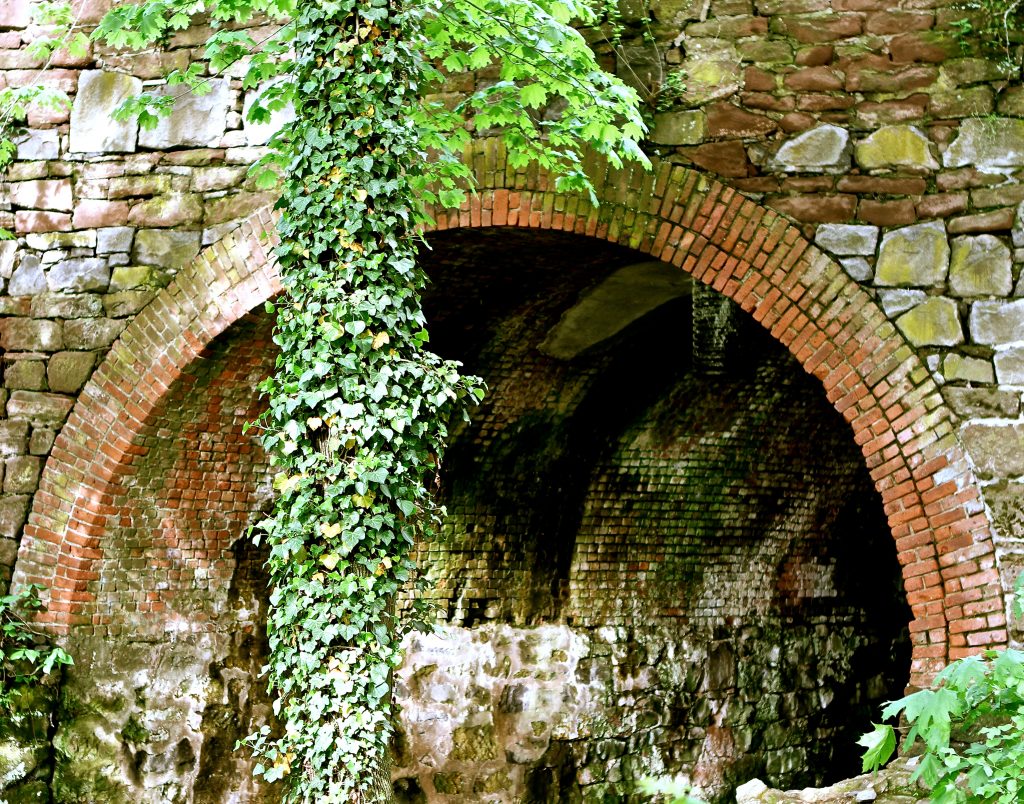
4.) Historical Black Church…still researching… 14 N Mill St, Nyack, NY 10960
5.) Cynthia Hesdra Street sign named in her honor…located at the corner of Depew Ave and Piermont in Nyack, New York. Directly across from the entrance to Memorial Park.
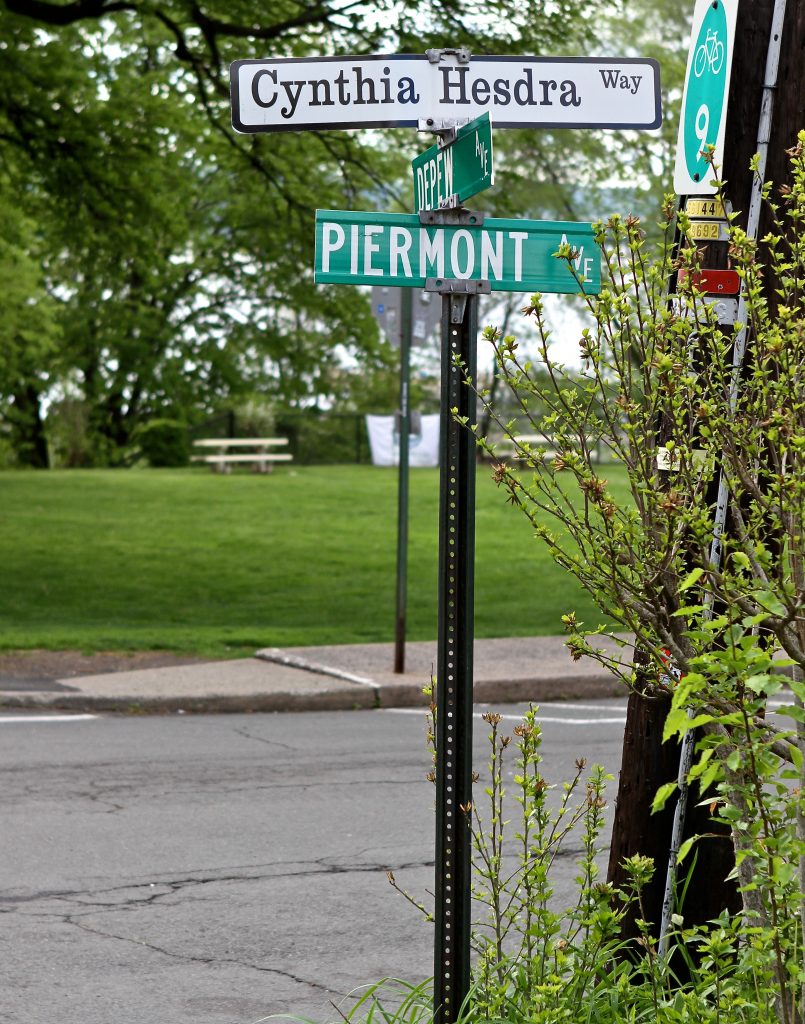
6.) The Honorary Cynthia Hesdra Park Bench overlooking Hudson River…Top section of Memorial Park on the far right side, just before the stone steps. Black wrought iron bench, only one of its type in the park.
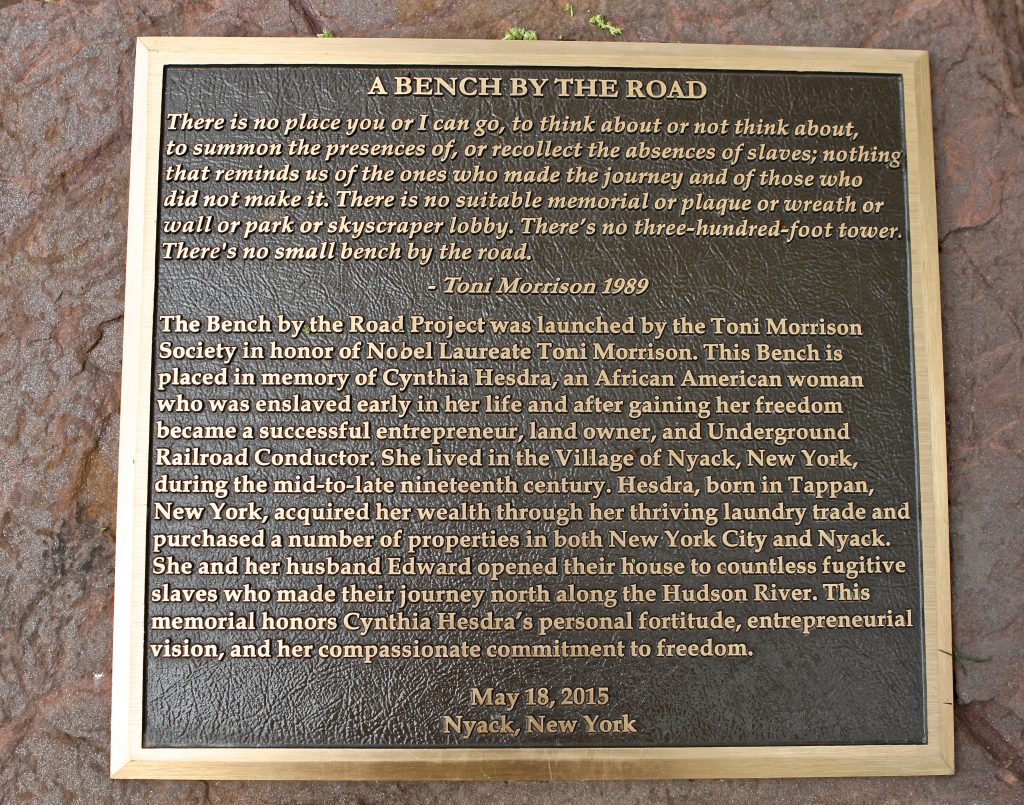

Both burial locations where Edward is buried and where Cynthia is buried are in a disgraceful condition. To complete your historical honors to both, you should consider moving both burials to your town. Cynthia is in the Fisher Rd. Cemetery in Mahwah, NJ and Edward is buried in Mokum-Slocum Cemetery in NY. After so many years of working so hard, this is the terrible end they came to abandoned locations rather than Nyack where they are honored.
I’ve been doing research on Cynthia and Edward Hesdra for years. She is buried in a family cemetery in Mahwah, NJ, in the middle of a private townhouse community, on land her father owned. I’ve been trying to have her memorialized with a plaque but have been blocked by some neighbors who don’t want anyone to know there’s a cemetery here. There’s an even older standing stone, dated 1831, but with stone flaked off. Her stone, which has been detached from its base, is a beautifully etched granite headstone, provided for in her and Edward’s wills. The Rockland County Historical Society is publishing an article about her soon. I’ve met with the editor.
And I’m in touch with a possible descendant of Edward through Richard Levine. Thank you for your interest!